|
|
|
|
|
|
|
Heather's Books |
|
- Seeking Peace: The Quakers
- Be Not Afraid: The Polish (R)evolution, "Solidarity."
- Who Were the Whiteoaks and Where Was Jalna?
- Mazo de la Roche: Rich and Famous Writer
- Wacousta
- Warsaw Spring
- A Drop of Rain
|
|
|
 |
|
Seeking Peace: The Quakers
by Heather Kirk
|
|
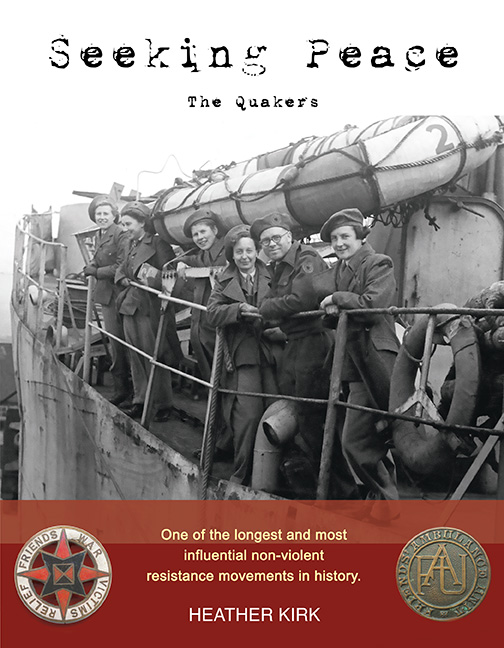
Who is the only person to have won an Olympic medal and a Nobel prize?
Philip Baker.
What kind of Olympic medal was it? Silver. Running. 1,500 metres. Antwerp. 1920.
What kind of Nobel prize was it? Peace. 1959.
What was Baker's religion?
Quaker.
The answers to many questions about the peace-loving Quakers can be found in a new publication by Canadian author, Heather Kirk.
The 272-page book, Seeking Peace: The Quakers, was published in Fall 2017 by Borealis Press of Ottawa, Ontario, Canada. The book is illustrated with almost 100 drawings, paintings, maps, and photographs.
Seeking Peace follows an earlier book by Kirk about another little-known, pacifist phenomenon, Poland's Solidarity uprising of the 1980's. That book was titled Be Not Afraid: The Polish (R)evolution, "Solidarity." It was published by Borealis in 2011 and received excellent reviews. (See the "Reviews" section of Kirk's website at www.heatherkirk.ca.)
The purpose of Seeking Peace is to introduce an "historic peace church" that is over 360 years old. The book is an exploration, not a hagiography. Critics' doubts are discussed.
Why is Kirk, best known for her books and articles on famous novelist Mazo de la Roche, writing about nonviolent-resistance movements that few have heard about?
"There are many nonfiction books about bloody wars," says Kirk, "but few about peaceful resolution of conflict. How can people learn to avoid war if they don't have interesting resources to explain how it has been done? And it has been done! The Poles and the Quakers and many others have done it-- even the Danes and the Mongolians. Gandhi, King, and Mandela are not exceptions now."
Seeking Peace is aimed at senior-high and freshman-college students as well as average, adult readers. Its style encourages skimming and scanning. The scholarly narrative is offered in short blocks separated by visual images as well as jokes, quotes, quizzes, questions, "geographies," mini biographies, brief dramatic scenes, timelines, and a song.
Poland's Solidarity movement was distinguished by the enormity and rapidity of its achievements. Without killing a single person, ten million people protested peacefully for ten years, thereby throwing off their communist rulers and helping bring down the Soviet Union.
Quakerism is impressive for the creativity and endurance of its so-called "peace testimony." This tiny sect, also known as the Friends or Religious Society of Friends, has accomplished astonishingly varied feats in its long existence.
While seeking peace among peoples, yesterday and today, Quakers have helped to promote religious liberty, to abolish slavery, to reform poor prison conditions, to improve mental hospitals, and to develop schools. All this and more without going to war.
Seeking Peace is a kaleidoscopic story made up of some of the many stories about what the Quakers have done--what they have stood for and even died for since they arose as a people in 17th-century England.
Now, can you name the "peculiar people" that helped create Amnesty International, Greenpeace and Oxfam? Hint: These people won the Nobel peace prize in 1947.
|
|
Heather Kirk in front of the Yonge Street 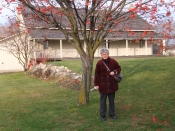 Meeting House, a continuous place of worship for Quakers for over 200 years. This historic site is located in Newmarket, Ontario, Canada. Meeting House, a continuous place of worship for Quakers for over 200 years. This historic site is located in Newmarket, Ontario, Canada.
|
|
 |
|
Be Not Afraid: The Polish (R)evolution, "Solidarity"
by Heather Kirk
|
|
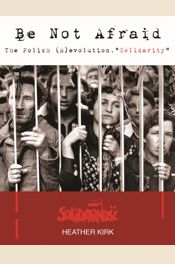 Be Not Afraid is an introduction for young adults and ordinary adults to the Polish non-violent resistance movement, “Solidarity.” As distinguished British historian Timothy Be Not Afraid is an introduction for young adults and ordinary adults to the Polish non-violent resistance movement, “Solidarity.” As distinguished British historian Timothy
Garton Ash has explained: Solidarity was “the icebreaker for the end of the Cold War.” It was also a “new model of revolution that supplanted the violent models of the French and Russian revolutions.”
Solidarity was a unique social movement that involved ten-million people over a period of ten years, from 1980 to 1989. Solidarity freed Poland from Soviet domination. It contributed greatly to the collapse of communism in Eastern Europe in 1989 and to the fall of the Soviet Union in 1991. And, amazingly, it killed precisely no one.
Be Not Afraid is for anyone wanting to learn the basics about the peaceful Polish revolution, “Solidarity.” Be Not Afraid is accessible and entertaining as well as informative. The text is meticulously documented but broken into brief, easily digested pieces and lightened with jokes, poems, songs, and imagined eyewitness scenes. Be Not Afraid offers suggestions for further exploration--interesting books, articles, films and music, as well as Internet sites. Be Not Afraid is generously illustrated with 94 world-class photos.
The author of Be Not Afraid, Heather Kirk, lived in Poland for several years, working at the University of Warsaw and the Polish Interpress Agency. Heather Kirk has published two young-adult novels about Poland: Warsaw Spring and
A Drop of Rain. She has also published several long poems and prize-winning articles about Poland for adults.
In revising Be Not Afraid, Heather Kirk worked closely with eminent Polish-American historian, Anna M. Cienciala, Professor Emeritus of History, Russian, East European and Eurasian Studies at the University of Kansas. Professor Cienciala is a co-editor of Katyn: A Crime Without Punishment (Yale University Press, 2007). Professor Cienciala read the manuscript of Be Not Afraid and made corrections and suggestions.

|
|
|
|
|
|
Who Were the Whiteoaks and Where Was Jalna?
by Heather Kirk
|
|
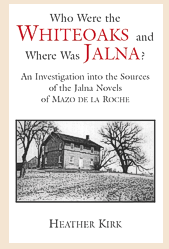 After 80 years the secret was revealed! After 80 years the secret was revealed!
In 1927, a novel called Jalna by a Canadian author named Mazo de la Roche won a major international prize and became a bestseller. Jalna and its first sequel, Whiteoaks of Jalna, inspired a 1935 Hollywood movie. These books also formed the basis of the first Canadian play to be mounted on a professional stage in London, England. Opening in April 1936, the play was a long-running hit. It toured England and went to Broadway.
De la Roche wrote sixteen Jalna novels in total, all of them bestsellers. By the time de la Roche died in Toronto in 1961, eleven million copies of the Jalna books had been sold in 93 languages. These books had represented Canada to the world for a generation.
The Jalna series was about a wealthy, aristocratic family surnamed Whiteoak who live somewhere in southern Ontario on an estate known as “Jalna.” De la Roche did not tell her readers what real people had inspired the fictional Whiteoak family or what real property had provided the model for Jalna. Fans could only guess. And they guessed wrong.
Finally, in 2007, the truth came out!
Who Were the Whiteoaks and Where Was Jalna? is an investigation into the sources of the Jalna novels of Mazo de la Roche. Published in October 2007 by Tecumseh Press, a division of Borealis Book Publishers of Ottawa, Ontario, this 210-page book is lavishly illustrated with photos, maps, charts, and drawings. It is the result of several years of careful research.
What new information about the Whiteoaks and Jalna did Heather Kirk discover?
Contrary to popular belief, Mazo de la Roche did not base the Whiteoaks primarily on one or more of the prominent families of southern Ontario with whom she was superficially acquainted. The Whiteoaks were not the Beardsmores of Acton, the Harrises of Clarkson, the Magraths of Erindale, the Masseys of Toronto, the Oslers of Bronte, the Sibbalds of Sibbald Point, or the Warnocks of Galt.
The Whiteoaks were an ingenious combination of de la Roche’s own family and the family of her cousin, life-long companion, and co-creator, Caroline Clement. These families were quite distinguished. They included knights of the Middle Ages, Old World aristocrats, a famous theologian, pioneers of Colonial America, United Empire Loyalists, heroes of the War of 1812, avant-gard Quakers, rebels of the 1837 Rebellion, Manitoba politicians, and a well-known industrialist in British Columbia. Even Laura Secord got into the mix!
The families of Mazo de la Roche and Caroline Clement owned large properties in York County and Simcoe County, north of Toronto. There were also important family properties in the Niagara region. Several of these properties were combined to create Jalna!
|
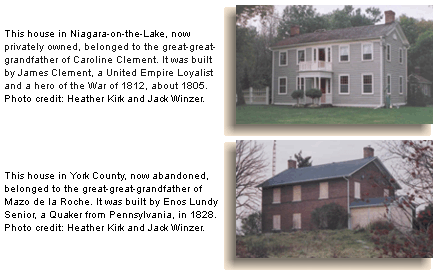 |
|
|
|
|
|
Mazo de la Roche: Rich and Famous Writer
by Heather Kirk
|
|
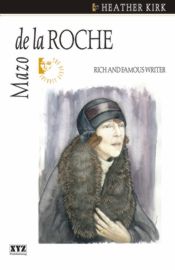 Finally! A reliable biography of Canadian author, Mazo de la Roche. This fun-to-read book is aimed at high-school students in Grades 10 to 12 and at adults who want a quick introduction to de la Roche. As well as conveying new facts about de la Roche, the biography entertains and informs with dramatic scenes that read like a novel. Finally! A reliable biography of Canadian author, Mazo de la Roche. This fun-to-read book is aimed at high-school students in Grades 10 to 12 and at adults who want a quick introduction to de la Roche. As well as conveying new facts about de la Roche, the biography entertains and informs with dramatic scenes that read like a novel.
Mazo de la Roche was the author of the famous Jalna series: sixteen novels about upper-class Englishman, Captain Philip Whiteoak, his aristocratic Irish wife, Adeline, and their descendants.The Whiteoaks live for a century between 1854 and 1954 on a rural estate in southern Ontario called Jalna.
De la Roche lived from 1879 to 1961. The first novel in the series was Jalna, published in 1927. Jalna won the international Atlantic Little Brown prize for best novel.
De la Roche became one of Canada’s wealthiest, most popular authors ever. Her Jalna books inspired a Hollywood film, Jalna, produced in 1935. They also formed the basis of a play, Whiteoaks (1936), the first Canadian play mounted in the prestigious West End theatre district of London, England. The play was a hit and went to Broadway.
The Jalna series represented Canada to the world for a generation. After the Second World War, in France, Mazo de la Roche was the most widely read author of any nationality. In communist Poland, Czechoslovakia, and Hungary, pirated editions of her novels circulated widely.
By the time de la Roche died in 1961, the Jalna series had sold eleven million copies in 193 English-language editions and 92 foreign-language editions. In 1972, the Canadian Broadcasting Corporation based a television series on the Jalna books. In 1994, France 2 TV also based a television series on the Jalna books.
“The creation of the Jalna books is the most protracted single feat of literary invention in the brief history of Canada’s literature,” said literary critic and novelist, Robertson Davies.
Yet, until now, a reliable biography of Mazo de la Roche has not been available. De la Roche was a very private person and obtaining information about her has been difficult.
All the previous biographers missed the fact that de la Roche spent about five years of her childhood and youth in Orillia, Ontario. Not one of the previous biographers discovered the true inspirations for the Jalna series.
Heather Kirk’s Mazo de la Roche: Rich and Famous Writer comes with a list of sources that shows that the exciting new facts in this biography have been checked with scholarly rigour.
|
|
|
|
|
|
|
|
|
|
Wacousta
by Heather Kirk
|
|
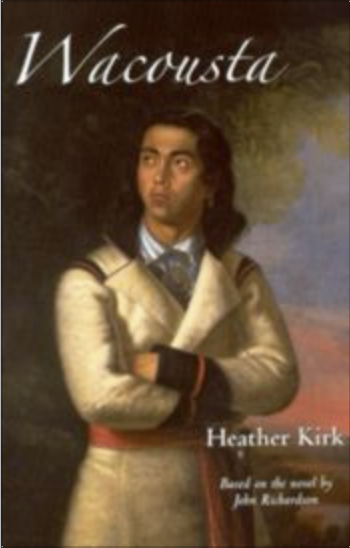 Why rewrite Wacousta? This tale of the famous Pontiac Uprising--the First Nations attacks on British forts on the Canadian frontier of 1763--was marvelously plotted and authentically detailed but inaccessible except to scholars of Canadian literature. Why rewrite Wacousta? This tale of the famous Pontiac Uprising--the First Nations attacks on British forts on the Canadian frontier of 1763--was marvelously plotted and authentically detailed but inaccessible except to scholars of Canadian literature.
The problem was not availability, it was readability. Several editions of Wacousta were in print, but John Richardson’s prose was dense and abstract. In short, he put the average contemporary reader to sleep. By rewriting Wacousta, Heather Kirk made this old classic, first published in 1832, a fast-paced, exciting read.
“I struggled through the original Wacousta for a university class,” wrote Heather Butt. “This version is a breath of fresh air.” Ms. Butt is a Heritage Services Representative with Windsor’s Community Museum in Windsor, Ontario.
“You have created a good novel that deserves a modern audience,” wrote Bob Garcia, Fort Henry Project Historian, Parks Canada.
A readable Wacousta fills a gap in what is available today in Canadian historical fiction. Most modern Canadian historical fiction gingerly sidesteps the greatest issue in Canadian history: the conflict between French and English. Wacousta illuminates the French-English conflict.
There is also a scarcity of material on early conflicts with First Nations peoples. Wacousta’s treatment of the Aboriginal point of view is intelligent. Its villain is a British renegade whose evil is still relevant today. Its principal heroes are the grown children of Chief Pontiac.
Richardson’s Wacousta is one of the best works of Canadian historical fiction ever written. It is a national treasure which captures Canada’s distant past magnificently. Also, the life of John Richardson, Canada’s first native-born novelist, a Métis and a soldier, is fascinating. You can read about his life in David Beasley’s The Canadian Don Quixote (Simcoe, ON: Davus Publishing, 2004).
John Moss in his Reader’s Guide to the Canadian Novel says: “Wacousta is at the centre of the Canadian tradition. Judged against Walter Scott’s historical romances or James Fenimore Cooper’s frontier romances, Wacousta is wondrously complex and enigmatic. Judged from a present perspective, within the tradition it so roundly represents, it is of major importance.”
Heather Kirk hopes her efforts in rewriting Wacousta will help lead to a renewed interest in the book and in Canadian history generally.
“I think knowing one’s own culture, having a sense of the place, a sense of the past and of one’s own people is very important. There isn’t enough of that.” So Heather told Paul Gessell of the Ottawa Citizen.
|
|
|
 |
|
Warsaw Spring
by Heather Kirk
|
|
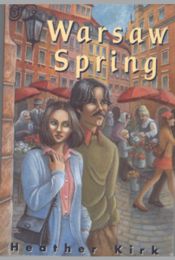 Warsaw Spring is a novel for young adults Warsaw Spring is a novel for young adults
set in Canada and Poland in the spring of 1979, the year before the Solidarity Uprising of August 1980.
The novel explores the effects of the Second World War on the country most devastated by that war. It examines the differences between capitalism and communism and points to how Poland eventually ended the Cold War
by toppling the Soviet regime. It also tells the story of one young woman’s search for her father.
Warsaw Spring is the first of two linked novels. Its sequel is titled A Drop of Rain.
Shunned by a social-climbing mother, raised by an overly-strict grandmother, eighteen-year-old Eva Goralski is the illegitimate daughter of a Polish war veteran whom she has never seen. As the story begins, Eva is a student at an Edmonton high school.
Bright and talented but troubled and questioning, she is not doing well at school, among peers, or at her part-time restaurant job. Arguments with her Canadian family and a near rape by her employer finally compel Eva to run away to her father’s family in Poland.
In Warsaw, Eva meets an older half-sister she never knew she had. This sister, Hanna, also has never seen their father. Gradually, despite Hanna’s mysterious silences, Eva learns about the complex, painful, personal and national tragedy that led to their father’s disappearance from their lives.
One of the ways that she learns is through a romance with a young, half-Jewish man, Mark, whose father is a highly placed member of the communist party.
Eva relives the Polish war experiences in Warsaw, Gdansk, and Auschwitz. She absorbs the dignity of ancient Cracow and the beauty of the Carpathian Mountains. She comes to understand the mood of despair that grips the exhausted country now under the control of the Soviet Union.
Eva witnesses the June 1979 pilgrimage to Poland of Pope John Paul II: the event that would ultimately spark the Solidarity Uprising. She encounters true heroism in her sister Hanna and other women of her father’s family.
In her search for her father, Eva grows in strength as well as understanding. She finds a place for herself in a bewildering but worthwhile adult world. She experiences the love of family and friends. She returns to Canada much changed for the better.
Research for Warsaw Spring included more than two years of residence in Poland, as well as many years of friendship with Polish people. Some of Heather Kirk’s poems and essays about Poland have been published in literary magazines.
|
|
|
 |
|
A Drop of Rain
by Heather Kirk
|
|
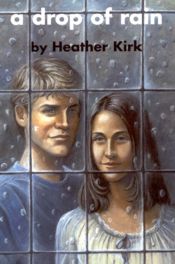 A Drop of Rain is the sequel to Warsaw Spring. The action takes place twenty years later. Through the journal entries of six A Drop of Rain is the sequel to Warsaw Spring. The action takes place twenty years later. Through the journal entries of six
people over a period of three months, from September 11 to December 31, 1999, emerges the story of a young woman finding strength and a broken family healing.
In September of 1999, Eva Goralski’s daughter, Naomi, is starting a new high school. Naomi has no money to buy nice clothes. The guy she likes is avoiding her. She’s worried that she might have AIDS. She’s never met her father, and she does
not like her mother’s boyfriend. As well as coping with all these problems, Naomi is supposed to do difficult homework for a
hated history course!
Things cannot get worse. Or can they? Naomi’s mother, Eva, is on the verge of a breakdown. Naomi’s aunt, Hanna Wojnar, is dying of breast cancer. And Naomi cannot talk to either one.
Naomi finds a part-time job and somebody to talk to: Mary, a Polish doctor forced to work as a cleaner in Canada. But the job is terrible, and Mary becomes deathly ill.
Naomi tries to escape her problems by winning the friendship of a girl at school, Sarah, who seems to have everything. Naomi also gains the attention of Curtis, a fascinating guy who seems strong and happy. But Naomi soon realizes that Sarah and Curtis have problems of their own.
Then, through her job as a cleaner, Naomi witnesses the sort of cruel experiences that led to Hanna’s losing her health. She begins to understand her mother and Hanna better.
The story of Naomi’s growing maturity is woven through the stories of Eva, Hanna, and Mary, three brilliant professional women whose lives have been shaped by the turbulent history of modern Poland: World War II, communism, and the Solidarity Uprising.
By the end of the novel, Naomi understands the sacrifices made by new immigrants to North America who do not speak good English. She has also decided that she might become a doctor. Naomi helps her mother and Hanna and saves Mary’s life. She also becomes true friends with Sarah and wins Curtis’s love. As well, she passes her history course.
“I got into it right away,” said Laina Smith, a Grade 12 student at Barrie North Collegiate. “It was very interesting. It has a deep message. I think other young people would like it. It’s for anyone up for a challenging and thought-provoking book.”
“I really enjoyed it,” said Andrea Ruttan, a Grade 11 student at Central High School in Barrie. “It is very well written. I could really relate to Naomi--her voice, the way she handled things. The book is about life problems that everyone deals with. It’s about how the family came together. It’s a really good story.” |
|
|
| Top |
|
 |
|